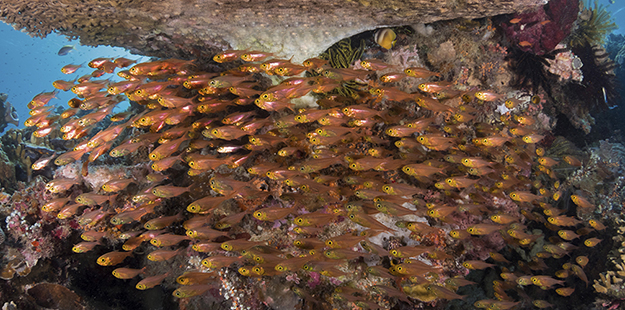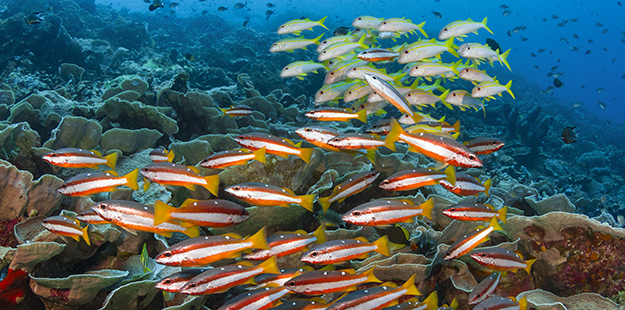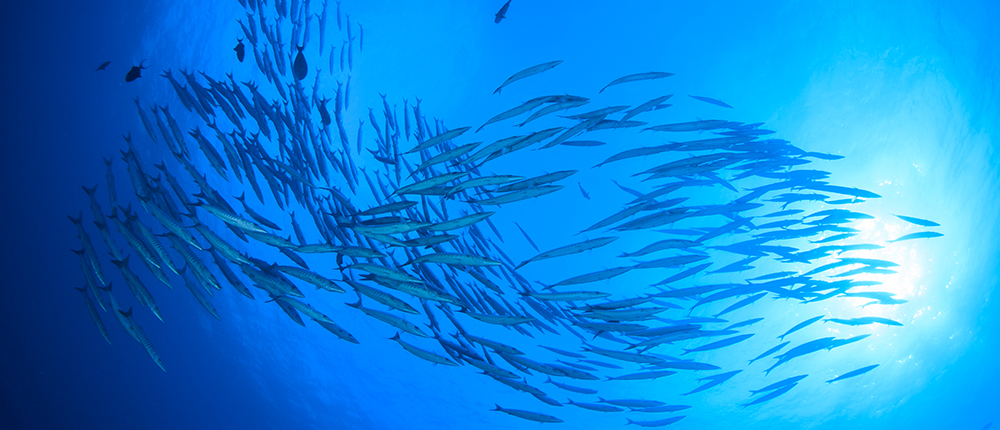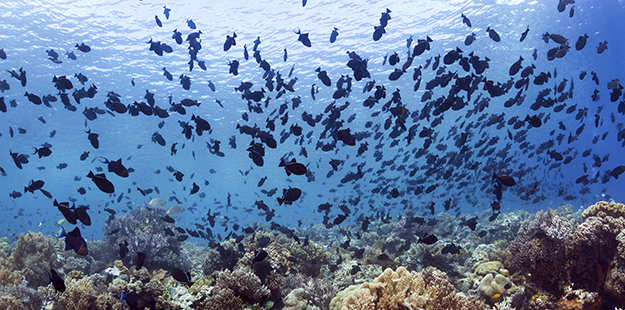School’s in Session
Discovering the many ways fish get together on the reefs of Wakatobi
Thanks to ongoing conservation efforts, there are lots of fish on the protected reefs around Wakatobi Resort. Some hide or swim around by themselves, but many more hang around with others of their kind or bunch up to move about in groups. Divers and snorkelers new to the underwater scene might describe all this activity as ‘just another school of fish.’ But more astute observers will soon begin to notice that there many different ways that schooling fish get together, and unique behavior patterns associated with each of these various gatherings.
Aggregate behavior
Certain dive sites seem to attract larger numbers of fish than others. This is especially true of seamounts, shipwrecks and other types of underwater structures that stand out from the surroundings. There may be dozens of different species flitting about or bunching up on these sites. Marine biologists would classify this sort of gathering as an aggregation rather than a school. Fish aggregate for a number of reasons, including food, shelter and sex. Sometimes, it’s as simple as using the hull of a ship or a protruding coral formation as a point of reference, a place to get out of the current or a haven from roving predators. Thinking in human terms, it would be like having a solitary picnic shelter in an open field. That’s where folks will likely gather.

There are various species in this group displaying an unstructured aggregation; think of as a social event, like people shopping at a big sale. Photo by Marco Fierli, marcof8.com
Fish also get together to feed. This will usually happen on sites where there is more on the menu, but it’s also a strategy for efficient feeding on any site, as it helps the group take full advantage of whatever forage there is. Much like shoppers swarming a mall during a big sale, an aggregation of fish will have the collective eyeballs needed to locate each available morsel, and a meal that might be missed by one individual will likely be spotted by another. The scientific term for this type of activity is an unstructured aggregation, because it will often include random mixtures of species, all foraging together.

These golden sweepers have gathered in a structured aggregation beneath a tabletop coral at Table Coral City.It’s nice to have a roof over your head. Photo by Walt Stearns
When fish gatherings are limited to a single species, they are generally referred to as a structured aggregation. Food and shelter are sometimes the reason for these gatherings, but more often, it’s sex. Spawning aggregations draw hundreds to thousands of individuals together for the purpose of procreation, and the event could last for just a few minutes or stretch out for months. Some spawns involve resident species that travel short distances for regular gatherings. This is a common practice for smaller, reef-dwelling fish, and there may be multiple spawns throughout the year—and sometimes on an almost daily basis. In certain species, the aggregations will continue long after the spawn is consummated, and will include a structured parenting arrangement such as the creation of a communal nesting site in a specific location on a reef or neighboring sand flat.
Shoal mates
Most of us would call a group of fish of the same species a school. But if you want to be technically correct, that’s not always the case. They might be a shoal. What’s the difference? As an example, let’s look at the midnight snappers that are commonly seen around Wakatobi dive sites such as Treasure Chest and Roma. They are hanging out together, but not exactly going anywhere. They are in essence shoaling. If the group were to take off swimming in the same direction in a coordinated manner, they would then be schooling.

Shoaling behavior can sometimes include fish of disparate sizes, or may include a second species as part of the whole group (an associated subgroup) such as these two-spot snappers and yellowfin goatfish. Photo by Walt Stearns
Shoaling behavior is the term used for a group of fish that “remain together for social reasons.” About a quarter of all fish shoal all their lives, and half will shoal up at one point or another. In general, fish will shoal with others of their own species, size and appearance. One of the primary benefits of this behavior is as defense against predators. Using the safety in numbers adage, more eyes means better predator detection. In addition, the group structure can work to confuse a would-be predator, and decrease each individual member’s chances of being singled out.
The intricacies of shoaling are not fully understood, however they generally follow patterns that can be readily identified. A common pattern is known as amorphous shoaling, in which fish appear to be swimming and foraging in a slightly independent fashion, but remain grouped together. You’ll see this at points all along reef escarpments at Wakatobi, where black durgon triggerfish move about much like a flock of birds. This is an example of an amorphous shoal.



